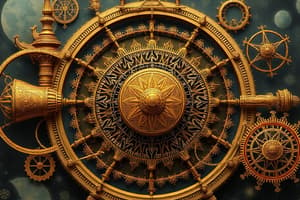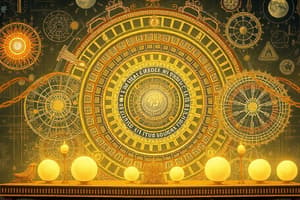Podcast
Questions and Answers
ما هو قانون نيوتن الذي يصف العلاقة بين القوة والتسارع والكتلة؟
ما هو قانون نيوتن الذي يصف العلاقة بين القوة والتسارع والكتلة؟
ما هو مفهوم اساسي في الديناميكا الحرارية يصف كمية الطاقة المخزنة في نظام؟
ما هو مفهوم اساسي في الديناميكا الحرارية يصف كمية الطاقة المخزنة في نظام؟
ما هي ظاهرة في مجال البصريات تُعرف بتغيير اتجاه الضوء عند الانتقال من وسط إلى آخر؟
ما هي ظاهرة في مجال البصريات تُعرف بتغيير اتجاه الضوء عند الانتقال من وسط إلى آخر؟
ما هي المعادلات التي تصف القوانين الأساسية للكهرومغناطيسية؟
ما هي المعادلات التي تصف القوانين الأساسية للكهرومغناطيسية؟
Signup and view all the answers
ما هو الفرع من الفيزياء الذي يصف سلوك المادة والطاقة على المستوى الذري ودون الذري؟
ما هو الفرع من الفيزياء الذي يصف سلوك المادة والطاقة على المستوى الذري ودون الذري؟
Signup and view all the answers
أيٌّ من المفاهيم التالية تعتبر جزءًا من ميكانيكا الكم؟
أيٌّ من المفاهيم التالية تعتبر جزءًا من ميكانيكا الكم؟
Signup and view all the answers
ما هو مفهوم الزمكان كما تم تقديمه في نظرية النسبية؟
ما هو مفهوم الزمكان كما تم تقديمه في نظرية النسبية؟
Signup and view all the answers
أيٌّ من التطبيقات التالية هو نموذج لتأثير ميكانيكا الكم في عالمنا اليومي؟
أيٌّ من التطبيقات التالية هو نموذج لتأثير ميكانيكا الكم في عالمنا اليومي؟
Signup and view all the answers
ما هو الاختلاف الرئيسي بين النسبية الخاصة والنسبية العامة؟
ما هو الاختلاف الرئيسي بين النسبية الخاصة والنسبية العامة؟
Signup and view all the answers
ما الذي يميز الفيزياء الحديثة عن الفيزياء الكلاسيكية؟
ما الذي يميز الفيزياء الحديثة عن الفيزياء الكلاسيكية؟
Signup and view all the answers
Study Notes
Classical Mechanics
- Classical mechanics describes the motion of macroscopic objects.
- It's based on Newton's laws of motion.
- Newton's first law: An object at rest stays at rest and an object in motion stays in motion with the same speed and in the same direction unless acted upon by an unbalanced force.
- Newton's second law: The acceleration of an object is directly proportional to the net force acting on it and inversely proportional to its mass. (F=ma)
- Newton's third law: For every action, there is an equal and opposite reaction.
- Key concepts include: force, mass, inertia, acceleration, momentum, energy, and work.
- Applications include: calculating trajectories of projectiles, analyzing the motion of vehicles, and understanding planetary orbits.
Thermodynamics
- Thermodynamics deals with heat, work, and temperature.
- It explores the relationship between thermal energy, mechanical energy, and other forms of energy.
- Key concepts: heat, temperature, internal energy, enthalpy, entropy, and the laws of thermodynamics (zeroth, first, second, and third).
- The laws of thermodynamics govern how energy is transferred and transformed in thermodynamic processes.
- Understanding heat engines and refrigerators involves applying thermodynamic principles.
Electromagnetism
- Electromagnetism studies the interaction between electric charges and magnetic fields.
- Key concepts: electric charge, electric field, electric potential, magnetic field, and electromagnetic forces.
- Electromagnetism explains phenomena like light, radio waves, and other electromagnetic radiation.
- Maxwell's equations describe the fundamental laws governing electromagnetism.
- Applications of electromagnetism are incredibly diverse, encompassing everything from electric motors and generators to radio and television transmission.
Optics
- Optics deals with the behavior of light and its interactions with matter.
- Key concepts: reflection, refraction, diffraction, interference, and polarization.
- The behavior of light is crucial for understanding vision, optical instruments (like microscopes and telescopes), and various optical phenomena.
- Geometric optics describes light propagation in straight lines, explaining reflection and refraction.
- Physical optics addresses wave phenomena like diffraction and interference.
Quantum Mechanics
- Quantum mechanics describes the behavior of matter and energy at the atomic and subatomic level.
- Key concepts: quantization of energy, wave-particle duality, Heisenberg's uncertainty principle, and quantum states.
- It's a revolutionary theory challenging classical physics notions.
- Quantum mechanics leads to novel phenomena not visible at macroscopic scales.
- Applications span quantum computing, materials science, and modern electronics.
Relativity
- Relativity encompasses special and general relativity.
- Special relativity describes the behavior of objects moving at constant velocities.
- General relativity describes gravity as the curvature of spacetime caused by mass and energy.
- Key concepts include: spacetime, time dilation, length contraction, and gravitational time dilation.
- Relativity is crucial for understanding phenomena happening in space at high speed and with strong gravitational fields.
- Predictions of relativity, like the expansion of the universe, are supported by astronomical observation.
Modern Physics
- Modern physics includes quantum mechanics, relativity, and other developments.
- It covers contemporary advancements in physics.
- Key areas encompass: particle physics, nuclear physics, and cosmology.
Studying That Suits You
Use AI to generate personalized quizzes and flashcards to suit your learning preferences.
Description
تتناول هذه الاختبارات أساسيات الميكانيكا الكلاسيكية وقوانين الديناميكا الحرارية. تشمل الموضوعات الرئيسية قوانين نيوتن للحركة ومفاهيم مثل القوة والكتلة والطاقة. ستساعدك هذه الاختبارات على فهم التطبيقات العملية لهذه المفاهيم في الحياة اليومية.




